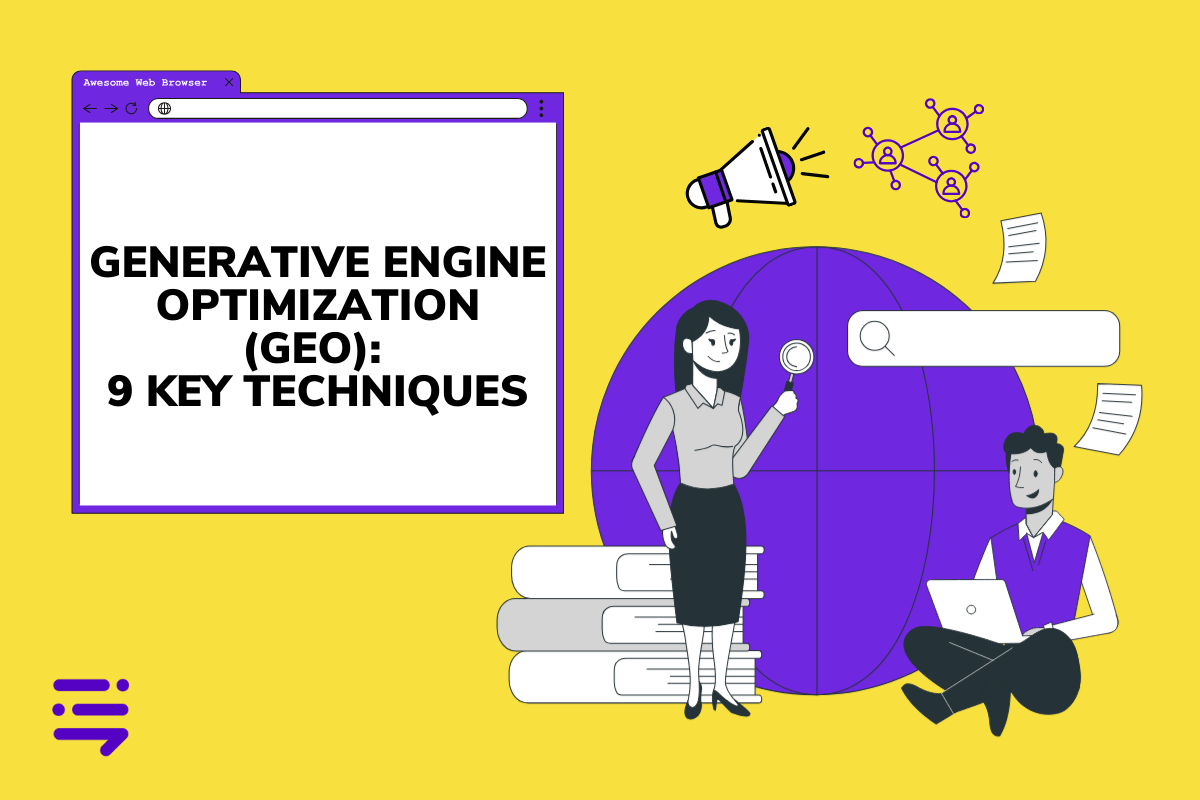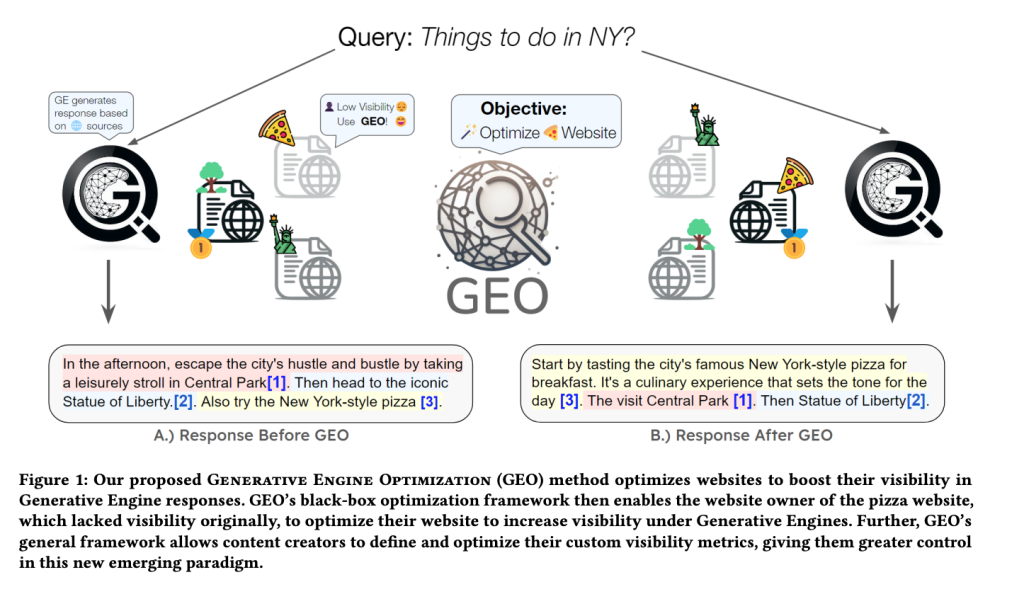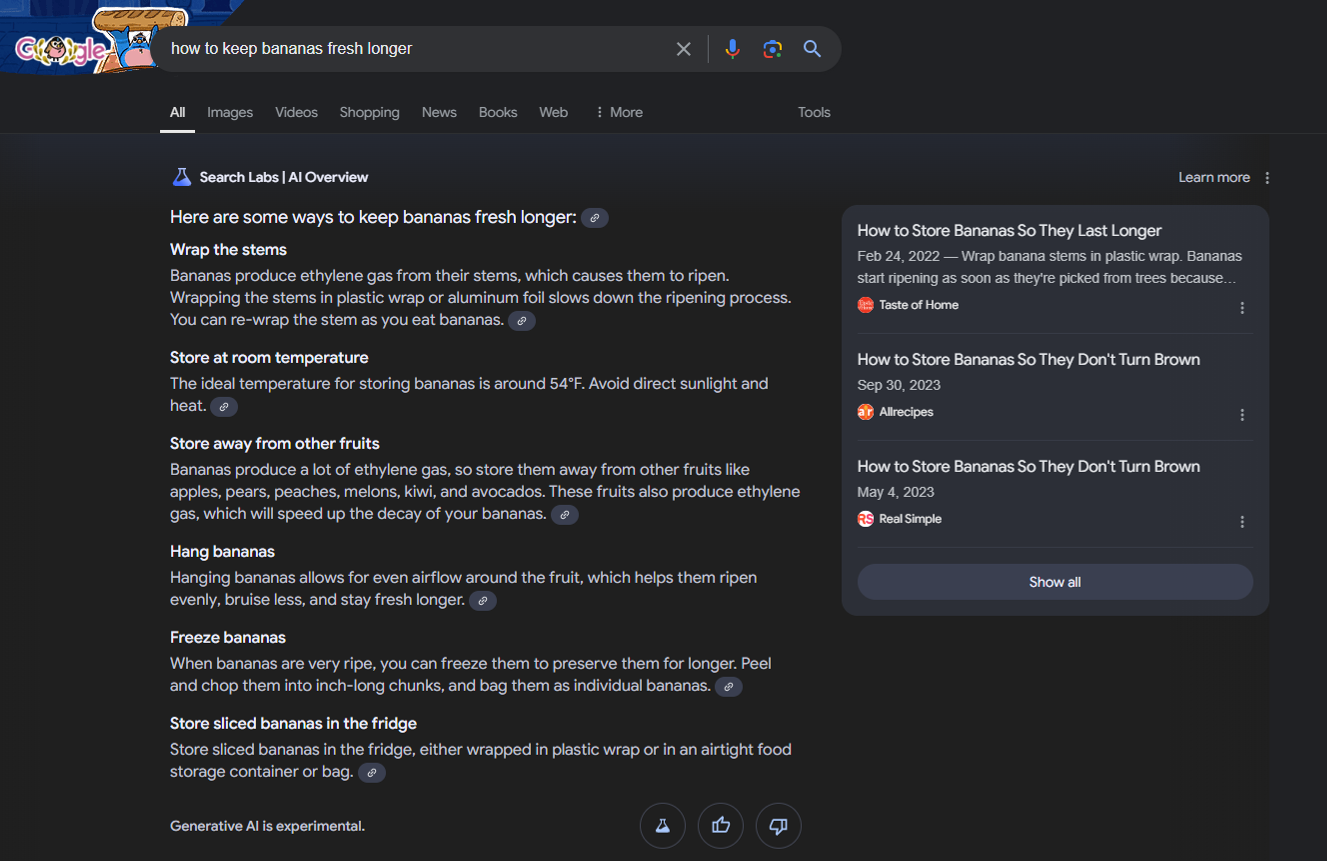Discover top guides, trends, tips and expertise from AIO Writers
Generative Engine Optimization (GEO): 9 Key Techniques
Julia McCoy
Thursday, 30th May 2024
Generative AI chatbots like ChatGPT and Gemini are now stealing the spotlight from traditional search engines because of their ability to provide quick and precise answers.
People would rather ask ChatGPT “What are some best practices for email marketing?” or “Can you explain SEO in simple terms?” instead of scrolling down a long page of search results.
This shift means marketers will now have to focus on optimizing content for generative AI search engines, or what we call generative engine optimization (GEO).
GEO techniques are designed to boost visibility and performance on these advanced AI platforms, pretty much how traditional search engine optimization helped brands take pole position on SERPs.
What exactly is GEO, and how can it help your website soar to new heights?
What is Generative Engine Optimization?
Generative Engine Optimization (GEO) is all about optimizing your content for the new age of search engines powered by artificial intelligence, also known as generative engines(GE).
In a study published by researchers from Princeton, Georgia Tech, The Allen Institute of AI, and IIT Delhia entitled “GEO: Generative Engine Optimization”, GEO is defined as:
“A novel paradigm to aid content creators in improving the visibility of their content in Generative Engine responses through a black-box optimization framework for optimizing and defining visibility metrics.”

SEO vs. GEO (Generative Engine Optimization)
Traditional SEO and Generative Engine Optimization are two approaches to optimizing content for search engines, but they target different kinds of engines:
Traditional SEO: Focuses on ranking higher in traditional search engines like Google and Bing. These engines return a list of web pages based on relevance to the user’s query. SEO considers factors like keyword placement, backlinks, content quality, and user experience.
Generative Engine Optimization (GEO): Optimizes content for visibility in generative search engines like Google’s AI Overview (formerly known as SGE), Microsoft Bing Copilot, and other AI-powered search engines. These are newer engines that use AI to analyze information from various sources and provide a more comprehensive response to the user’s query, potentially combining text, images, and other media. GEO prioritizes informative content that is engaging and caters to the way AI algorithms process information.

9 Generative Engine Optimization Techniques
Alright, so you know GEO is important in modern content optimization. But how do you actually do it?
After analyzing 10,000+ search queries from Google, Bing, Perplexity.AI, and GPT-4, the team introduced a nine-point content optimization technique to help boost content visibility and ranking in this new era of search. Here are nine essential techniques for search engine optimization in the era of Gen AI:
1. Authoritative Content
First up, authoritative content. You need to establish yourself as a trusted source in your niche. That means creating in-depth, well-researched content that is trustworthy.
Don’t just scratch the surface – dive deep into your topic and provide unique insights that your readers can’t find anywhere else. Back up your claims with data, case studies, and real-life examples.
For instance, instead of saying “Many believe reading is beneficial,” you could say “Educators highly advocate reading as a cornerstone of intellectual development.”
The latter carries more weight and credibility, fostering trust in what you are saying.
2. Keyword Placement
Similar to keyword placement in traditional SEO techniques, you should spread relevant keywords throughout your content to boost your place in generative engines.
But don’t overdo it with keyword stuffing. Use keywords naturally and in context. Focus on creating valuable content first, and then optimize for keywords later.
Try to maintain a keyword density between 1% and 2% and incorporate LSI variations, long-tail phrases, and “People Also Ask” keywords to broaden the scope of your content.
3. Statistics
Numbers don’t lie. Including statistics and citing reputable sources in your content can add credibility and trustworthiness to your claims.
But make sure you’re using up-to-date and accurate data from reliable sources.
4. Source Citing
When mentioning a statistic, always add a link to your source. Sharing a fact gains more credibility when you say, “I found it in a scientific study” — that’s what source citing means in generative search.
Your website can elevate its position in generative search results by referencing the most reputable sources. It not only gives credit where it’s due but also shows that you’ve done your homework.
5. Quotes
Another way to add depth and reliability to your content is by including relevant quotes from industry experts or thought leaders.
But don’t just throw in random quotes for the sake of it. Make sure they add value to your content and support your arguments.
For example, if you’re selling a new brand of dog food, it’s best to quote an expert in your niche. When pet owners see a recommendation from a renowned veterinarian, it makes them more confident in what you’re saying. This is similar to trusting a friend’s recommendation on a topic they are highly knowledgeable about.
6. Readability
Here’s the thing – even if you have the most authoritative and well-researched content, it won’t matter if your readers can’t understand it.
That’s why readability is crucial. Use simple language, short sentences, and clear formatting to make your content easy to read and digest.
Break up long paragraphs into shorter ones, use bullet points or numbered lists when appropriate, and add visual elements like images or videos to break up the text.
7. Fluency
In the same vein, you should optimize your content for fluency.
What is fluency optimization?
Let’s compare these two sentences:
“Let’s pool our creative talents.”
“Let’s combine our artistic abilities!”
Which phrase reads better? The second one, right?
Search engine algorithms also recognize fluent content from awkwardly constructed text.
If your website presents information fluently, it stands a better chance of ranking higher in SGE results.
To enhance your content’s fluency:
- Replace complete sentences with simple ones.
- Keep your audience engaged by avoiding monotonous writing.
- Opt for clear language over industry jargon.
- Ensure a seamless flow of ideas throughout your content.
- Write with rhythm to encourage readers to scroll to the end.
8. Unique Words
Don’t be afraid to use unique words in your content — as long as they’re relevant, add value, and are easy to understand.
Again, let’s compare two examples:
“The dog played in the park.”
“The energetic pup hopped joyfully around the lush greenery.”
The second sentence sounds more interesting because it uses unique words.
But remember, don’t sacrifice readability for terms that your readers might not be familiar with. Use unique words just to make your content more engaging.
9. Technical Terms
Although we normally stay away from jargon, you may consider using technical terms if you’re addressing an audience within a particular discipline.
For example:
“The doctor checked my heart and said everything was fine.”
“The cardiologist confirmed that my cardiac rhythm is normal.”
In the second sentence, the use of the technical term “cardiologist” provides more specific information to those familiar with the subject.
Why Does GEO Matter to Marketers?
According to the authors of the paper:
“Websites that are ranked lower in SERP, which typically struggle to gain visibility, benefit significantly more from GEO than those ranked higher … For instance, the Cite Sources method led to a substantial 115.1% increase in visibility for websites ranked fifth in SERP, while on average the visibility of the top-ranked website decreased by 30.3%.”
Among its findings, adding relevant statistics, quotations, and citations to content resulted in a 40% increase in content visibility in generative engines.
Conclusion
Generative Engine Optimization techniques are the future of SEO. By leveraging the power of AI and machine learning, you can create content that not only ranks higher in search results but also resonates with your target audience on a deeper level.
From crafting authoritative content to strategically placing keywords and citing reliable sources, these 9 GEO techniques will help you optimize your website for maximum visibility and engagement.
Start implementing these game-changing Generative Engine Optimization techniques today and watch as your website becomes the talk of the town. Trust me, your future self will thank you.

UNLOCK YOUR POTENTIAL
Long Headline that highlights Value Proposition of Lead Magnet
Grab a front row seat to our video masterclasses, interviews, case studies, tutorials, and guides.



